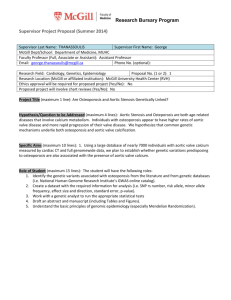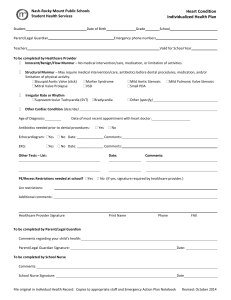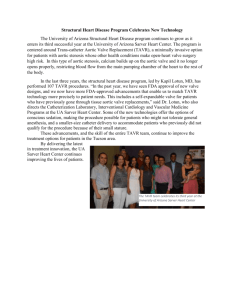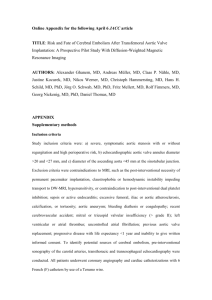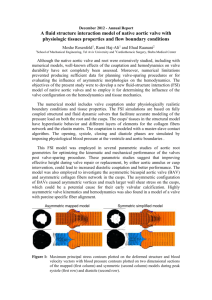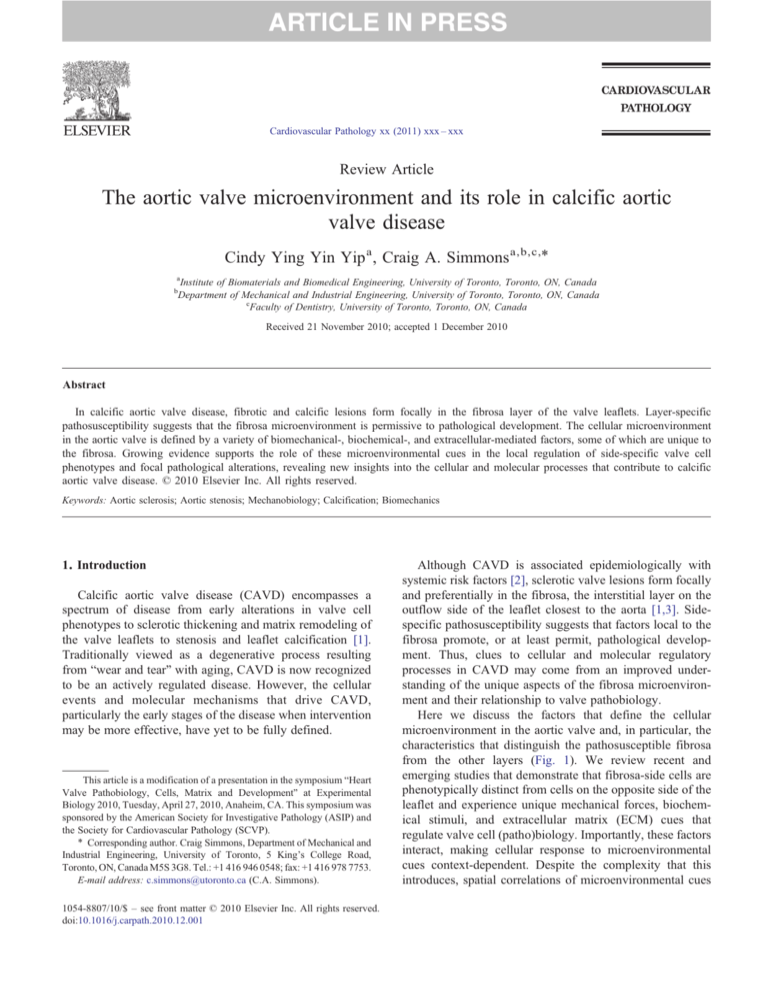
Cardiovascular Pathology xx (2011) xxx – xxx
Review Article
The aortic valve microenvironment and its role in calcific aortic
valve disease
Cindy Ying Yin Yip a , Craig A. Simmons a,b,c,⁎
a
b
Institute of Biomaterials and Biomedical Engineering, University of Toronto, Toronto, ON, Canada
Department of Mechanical and Industrial Engineering, University of Toronto, Toronto, ON, Canada
c
Faculty of Dentistry, University of Toronto, Toronto, ON, Canada
Received 21 November 2010; accepted 1 December 2010
Abstract
In calcific aortic valve disease, fibrotic and calcific lesions form focally in the fibrosa layer of the valve leaflets. Layer-specific
pathosusceptibility suggests that the fibrosa microenvironment is permissive to pathological development. The cellular microenvironment
in the aortic valve is defined by a variety of biomechanical-, biochemical-, and extracellular-mediated factors, some of which are unique to
the fibrosa. Growing evidence supports the role of these microenvironmental cues in the local regulation of side-specific valve cell
phenotypes and focal pathological alterations, revealing new insights into the cellular and molecular processes that contribute to calcific
aortic valve disease. © 2010 Elsevier Inc. All rights reserved.
Keywords: Aortic sclerosis; Aortic stenosis; Mechanobiology; Calcification; Biomechanics
1. Introduction
Calcific aortic valve disease (CAVD) encompasses a
spectrum of disease from early alterations in valve cell
phenotypes to sclerotic thickening and matrix remodeling of
the valve leaflets to stenosis and leaflet calcification [1].
Traditionally viewed as a degenerative process resulting
from “wear and tear” with aging, CAVD is now recognized
to be an actively regulated disease. However, the cellular
events and molecular mechanisms that drive CAVD,
particularly the early stages of the disease when intervention
may be more effective, have yet to be fully defined.
This article is a modification of a presentation in the symposium “Heart
Valve Pathobiology, Cells, Matrix and Development” at Experimental
Biology 2010, Tuesday, April 27, 2010, Anaheim, CA. This symposium was
sponsored by the American Society for Investigative Pathology (ASIP) and
the Society for Cardiovascular Pathology (SCVP).
⁎ Corresponding author. Craig Simmons, Department of Mechanical and
Industrial Engineering, University of Toronto, 5 King's College Road,
Toronto, ON, Canada M5S 3G8. Tel.: +1 416 946 0548; fax: +1 416 978 7753.
E-mail address: c.simmons@utoronto.ca (C.A. Simmons).
1054-8807/10/$ – see front matter © 2010 Elsevier Inc. All rights reserved.
doi:10.1016/j.carpath.2010.12.001
Although CAVD is associated epidemiologically with
systemic risk factors [2], sclerotic valve lesions form focally
and preferentially in the fibrosa, the interstitial layer on the
outflow side of the leaflet closest to the aorta [1,3]. Sidespecific pathosusceptibility suggests that factors local to the
fibrosa promote, or at least permit, pathological development. Thus, clues to cellular and molecular regulatory
processes in CAVD may come from an improved understanding of the unique aspects of the fibrosa microenvironment and their relationship to valve pathobiology.
Here we discuss the factors that define the cellular
microenvironment in the aortic valve and, in particular, the
characteristics that distinguish the pathosusceptible fibrosa
from the other layers (Fig. 1). We review recent and
emerging studies that demonstrate that fibrosa-side cells are
phenotypically distinct from cells on the opposite side of the
leaflet and experience unique mechanical forces, biochemical stimuli, and extracellular matrix (ECM) cues that
regulate valve cell (patho)biology. Importantly, these factors
interact, making cellular response to microenvironmental
cues context-dependent. Despite the complexity that this
introduces, spatial correlations of microenvironmental cues
2
C.Y.Y. Yip, C.A. Simmons / Cardiovascular Pathology xx (2011) xxx–xxx
Fig. 1. Microenvironmental factors that potentially play a role in pathological differentiation of VICs and lesion formation in the fibrosa layer of the aortic valve. The
fibrosa is the preferred site for low-density lipoprotein (LDL) accumulation, possibly due to trapping in the proteoglycans that accumulate in early valve sclerosis.
Oxidatively modified LDL (oxLDL) can inflame the endothelium to attract and bind monocytes, and active macrophages, which are found primarily in the fibrosa.
Activated macrophages produce enzymes like MMPs that mediate ECM remodeling and cathepsin S that fragments elastin, and cytokines like TGF-β1, TNF-α,
IL-1β, and RANKL, all of which can potentiate VIC pathological differentiation to myofibroblast and/or osteoblast lineages. Valvular interstitial cell
differentiation to osteoblasts may occur via a transitional myofibroblast state, but this has not been demonstrated conclusively. Extracellular matrix remodeling and
degradation products can affect VIC activation and differentiation. Valvular interstitial cells, particularly those that are activated, synthesize and remodel the ECM,
and produce cytokines, like TGF-β1, that can act in an autocrine/paracrine manner (not shown). Hemodynamic shear stresses caused by disturbed flow on the
fibrosa side of the valve may be responsible for the local VECs producing pathological paracrine factors, like BMP4. In contrast, ventricularis-side VECs, which
experience high magnitude and unidirectional shear stress, produce paracrine factors like OPG and CNP, which may inhibit pathological differentiation of VICs
locally. The VIC response to biochemical and ECM cues is modulated by the local mechanical environment; in particular, the larger strains and stiffer matrix in the
fibrosa (large green arrows) may provide a microenvironment that is mechanically permissive for cytokine-induced pathological development. Additionally, VICs
and VECs both exhibit layer/side-specific phenotypic differences and respond differentially to some microenvironmental and systemic cues (see the text for
details). The spongiosa also contains VICs, but less is known about its microenvironment and the phenotypic characteristics of the cells in this layer.
with pathological outcomes have driven discovery of several
key regulators of CAVD, as summarized below.
2. Spatial heterogeneity in valve cell populations
The focal nature of CAVD and the susceptibility for
lesions to occur in the fibrosa may be influenced in part by
the characteristics of the cells that populate the fibrosa layer.
The primary cell types in the aortic valve are valvular
endothelial cells (VECs) and valvular interstitial cells
(VICs). Recent evidence suggests that both of these
populations are heterogeneous and exhibit striking sidedependent phenotypic differences that have the potential to
contribute to the focal nature of CAVD.
Valvular endothelial cells form a monolayer that lines the
surface of the valve leaflets, separating the circulation from
the valve interstitium. As in the vasculature, the endothelium
is involved in valve homeostasis and pathology through its
principal functions of the maintenance of anticoagulant
properties, the regulation of leaflet permeability, and the
initiation and regulation of inflammation and associated
pathological consequences. Additionally, the valvular endothelium regulates VIC function through paracrine signals,
such as controlling VIC contractility and leaflet mechanics
[4]. Of note, VECs from opposite sides of normal porcine
leaflets display globally distinct gene expression profiles [5],
indicating side-dependent endothelial phenotypes. As discussed below, side-dependent VEC phenotypes may be
regulated in part by the distinct hemodynamic environments
on opposite sides of the valve. This spatial heterogeneity may
contribute to the susceptibility of the fibrosa to lesion
formation through differential regulation of permeability,
adhesiveness to inflammatory cells, and paracrine signaling to
local VICs and circulating cells. As examples of the latter, the
fibrosa side endothelium displays a “calcification permissive”
transcriptional profile characterized by increased expression
of bone morphogenetic protein 4 (BMP4) and decreased
expression of multiple inhibitors of fibrosis and calcification,
including osteoprotegerin (OPG), C-type natriuretic peptide
(CNP), and chordin [5]. In the normal valve, this apparent
C.Y.Y. Yip, C.A. Simmons / Cardiovascular Pathology xx (2011) xxx–xxx
vulnerability is balanced by an enhanced antioxidative
transcriptional profile on the fibrosa side, which may protect
against inflammation and lesion initiation. Side-specific
endothelial phenotypic heterogeneity was also evident in
swine challenged with a hypercholesterolemic (HC) diet for
2 weeks or 6 months [6]. Unexpectedly, systemic insult
resulted in induction and persistence of a protective
endothelial phenotype on the pathosusceptible aortic side,
including downregulation of tumor necrosis factor (TNF)-α
and nuclear factor (NF)-κB pathways. Notably, the aortic side
endothelium was more responsive to the HC diet than the
adjacent ventricular side endothelium, as measured by sidespecific global gene expression; differential sensitivity
between the two populations to a systemic stimulus may
explain in part side-specific pathosusceptibility.
The other main valvular cell type is the VICs, a
heterogeneous population of fibroblasts, with a small
population (∼1-5%) of myofibroblasts and smooth muscle
cells [7–11]. Within the VIC population is a subpopulation
of mesenchymal progenitor cells with multilineage differentiation potential [12]. These progenitors are likely the
primary source of the pathological cells — primarily
myofibroblasts and osteoblasts — that are most often
observed in diseased valves. Myofibroblasts comprise up
to 30% of the total VIC population in sclerotic leaflets [8,9].
Osteoblast-like cells that express bone sialoprotein, osteocalcin, alkaline phosphatase, and runt-related transcription
factor 2 (Runx2) are found in human calcified aortic valves,
associated with ectopic bone and cartilage tissue [13,14]. It is
conceivable that the tendency for myofibroblasts and
osteoblasts to appear in the fibrosa may reflect differential
plasticity of fibrosa-layer VICs vs. those from the other
layers. Emerging evidence from our lab suggests that this is
the case, at least for myofibroblasts (Likhitpanichkul and
Simmons, unpublished data). Counterintuitively, ventricularis-layer VICs have greater myofibroblast differentiation
potential than fibrosa-layer VICs in response to profibrotic
mechanical and biochemical stimuli in vitro. This suggests
that fibrosa-layer VICs are inherently less sensitive to
profibrotic signals; perhaps this serves as a homeostatic
mechanism to counter the many pathological microenvironmental challenges VICs face in the fibrosa (outlined below).
Further investigation of this hypothesis and spatially
heterogeneous VIC populations is required to establish the
implications for valve homeostasis and disease.
3. Local mechanical stimuli
Owing to its location between the left ventricle and aortic
root, the aortic valve experiences hemodynamic shear stresses,
pressure loads, and flexural deformations that are unlike those
experienced by any other tissue in the body. Aortic valve
mechanics have been well studied, particularly in the context
of the design and failure analysis of mechanical and
bioprosthetic valves [15,16]. Native aortic valve pathologies
3
have also been linked to mechanical factors, primarily based
on observations that calcific lesions correlate spatially with
regions that experience disturbed hemodynamic flow [5] and
high bending stresses [17]. Until recently, it was presumed that
these biomechanical forces instigate disease solely by
damaging the endothelium [18] or the interstitial matrix [19].
While “wear and tear” may contribute to valve disease, it is
increasingly clear that mechanical forces actively regulate
valve cell phenotypes and function to contribute to valve
homeostasis and pathobiology (reviewed in [20]). Notably, the
hemodynamic and biomechanical forces experienced by valve
cells differ on opposite sides of the valve leaflets. As discussed
below, this suggests that side-specific pathosusceptibility may
result in the fibrosa being a mechanically permissive
environment for pathological development.
Perhaps the clearest biomechanical difference between the
ventricularis and the fibrosa is the local patterns of blood flow.
During systole, the ventricular side of the aortic valve leaflets
is subjected to unidirectional laminar fluid flow that exerts
shear stresses on the endothelium of up to 80 dyne/cm2 [21]. In
contrast, the fibrosa side endothelium on the “back side” of the
leaflet experiences disturbed, oscillatory flow with shear stress
magnitudes ranging from −8 to +10 dyne/cm2. This led us to
postulate that local hemodynamic factors contribute to
differential endothelial phenotypes that define the sidedness
of the valve and the focal susceptibility to calcification [5,22].
Consistent with this hypothesis, oxidative, inflammatory, and
chondrogenic/osteogenic gene expression profiles are upregulated in VECs grown under static conditions (mimicking the
fibrosa side) vs. steady shear stress conditions (mimicking the
ventricularis side) in vitro [23]. Similarly, side-specific
endothelial phenotypes in vivo may be determined in part by
the local hemodynamic environment, although causality has
yet to be demonstrated [5]. Intriguingly, altered hemodynamics caused increased expression of endothelial adhesion
molecules (vascular cell adhesion molecule-1 and intercellular
cell adhesion molecule-1) in a transforming growth factor
(TGF)-β1- and BMP4-dependent manner in VECs on the
fibrosa side of porcine aortic valves, but not in VECs on the
ventricularis side [24]. Thus, side-specific endothelial phenotypes appear to have differential sensitivity to mechanical
factors, perhaps explaining in part fibrosa susceptibility to
CAVD when hemodynamic forces are altered in hypertensive
patients and in those with bicuspid valves.
While VICs are shielded from shear stresses, they are
subjected to mechanical deformation through interactions
with their ECM, which itself deforms throughout the cardiac
cycle as the valve leaflets open and close. Pathological stretch
of aortic valve cusps increases VIC expression of remodeling
enzymes, proinflammatory proteins, and pathological phenotypic markers [25–27]; these changes occur predominantly
in the fibrosa, perhaps reflecting differences in cellular level
strains in the different layers, even when leaflets are subjected
to nominally uniform stretch. In support of this idea, VIC
deformation is the greatest in the fibrosa in leaflets subjected
to diastolic transvalvular pressures [28].
4
C.Y.Y. Yip, C.A. Simmons / Cardiovascular Pathology xx (2011) xxx–xxx
Layer-dependent differences in VIC strains could result
from differences in the mechanical properties, structure, and
residual strain in each of the layers. Indeed, mechanical
testing of separated fibrosa and ventricularis layer tissue
confirmed that the fibrosa is stiffer than the ventricularis
[29,30]; we used a micropipette aspiration technique to
obtain a similar result in intact leaflets [31]. We also
observed considerable heterogeneity in the focal stiffness
within both layers, with distinctly stiff and soft regions in the
fibrosa and ventricularis, respectively. The inherent stiffness
of the ECM is an important factor in the VIC microenvironment, as it defines not only how externally applied strains
are transduced from the ECM to the cell, but also the
resistance the ECM offers to cell-generated tractional forces.
As with mesenchymal stem cells from other sources [32],
ECM stiffness regulates a wide range of VIC functions. For
example, we showed that VICs preferentially differentiate to
osteoblasts and form bone nodules on type I collagen-coated
matrices that mimic the stiffer regions of the normal fibrosa
[33]. Valvular interstitial cells differentiate to myofibroblasts
on even stiffer matrices (that mimic sclerotic tissue) [33,34],
but not on softer matrices that mimic the ventricularis [35].
Similarly, VICs differentiated to myofibroblasts on fibrinmodified stiff tissue culture-treated polystyrene but not on
fibrin-modified soft polyethylene glycol hydrogels [36].
The collective implication of these studies is that the
greater mechanical strain and stiffer ECM experienced by
VICs in the fibrosa layer promote pathological development
locally. However, it is unlikely that these mechanical cues
are solely responsible for driving VIC pathological differentiation; rather, the local mechanical environment likely
regulates VIC fate by modulating cellular response to other
microenvironmental stimuli, including cytokines and growth
factors. For example, TGF-β1 induction of VIC myofibroblast differentiation occurs only on substrates that are at least
as stiff as high-stiffness regions of the normal fibrosa,
through a mechanism that involves Wnt/β-catenin signaling
[35]. Thus, the preferential occurrence of myofibroblasts and
osteoblasts in the fibrosa layer in CAVD may be due to focal
regions in the fibrosa that provide a local mechanical
environment that permits or even is required for VIC
responsiveness to other pathological stimuli.
Compared to normal human aortic valves, there is abundant
expression of TGF-β1 in stenotic valves, accompanied by a
moderate decrease in TGF-β1 receptors RI and RII [38].
Transforming growth factor-β1 induces VIC myofibroblast
differentiation [39] via Smad-dependent pathways [40],
stimulates matrix metalloproteinase (MMP)-2 and MMP-9
expression [41], and increases contractility [33], which can
lead to apoptosis-dependent calcification in vitro [33,38].
Bone morphogenetic proteins are also upregulated in
calcified aortic valves [42]. In vitro, BMP2, BMP4, and
BMP7 promote calcification by VICs [13,43].
As implied in the previous sections, paracrine factors
expressed on a specific side of the leaflet may contribute to
the local biochemical milieu to protect against pathological
development. For example, we identified greater expression
of OPG, CNP, and chordin on the disease-protected
ventricular side of normal leaflets [5]. Each of these secreted
proteins is putatively protective: OPG suppresses cardiovascular calcification [44], and in its absence, receptor activator
of NF-κB ligand (RANKL) is able to bind RANK on VICs to
cause elevated MMP-1 and MMP-2 activities [45], DNA
binding activity of Runx2, bone-related matrix protein
expression, and calcification in vitro [46]; CNP inhibits
myofibroblast and osteogenic differentiation of VICs in vitro
[47]; and chordin is a BMP antagonist.
Importantly, and as discussed in the previous section, the
effects of some cytokines and growth factors are modulated by
the mechanical environment [33,35]. Thus, cytokine signaling
in CAVD is context-dependent, with valve mechanics
contributing substantially to the microenvironmental context.
The implication, therefore, is that the susceptibility of the fibrosa
to lesion formation results from it being both a mechanically
permissive and biochemically rich environment for pathological development. An additional implication of mechanical
context-dependent cytokine signaling is that the effects
observed in VICs grown on stiff tissue culture polystyrene
may not be physiologically relevant or apply to cells grown on
softer substrates that mimic valve tissue. The inability of TGFβ1 to induce myofibroblast differentiation on soft, ventricularislike substrates is an excellent example [33–35].
5. Local ECM cues
4. Local biochemical stimuli
Early CAVD involves lipoprotein deposition [3] and
macrophage and T-lymphocyte infiltration [1] in the fibrosa.
Oxidized low-density lipoproteins and cytokines produced
by activated macrophages and lymphocytes contribute to a
local biochemical milieu in the fibrosa that promotes
inflammation, oxidative stress, matrix remodeling, VIC
pathological differentiation, and fibrosis and calcification
(reviewed in [37]).
Many of these factors mediate CAVD in part through
pathways involving the activation of TGF-β1 and BMPs.
Beyond its structural role, the ECM provides biochemical
and, as discussed above, mechanical cues to adherent cells.
Alterations in ECM composition [48] and mechanics [49] are
characteristic of sclerotic diseases. In CAVD, the fibrosa is
particularly prone to remodeling, including disruption and
disorganization of collagen bundles [50], fragmentation and
stratification of elastin fibers, and increased proteoglycan
deposition [48]. Extracellular matrix remodeling is mediated
by MMPs, many of which are upregulated and/or have
increased activity in calcified aortic valves [50,51], and
cathepsin S, a potent elastase that is associated with valvular
calcification in a mouse model of chronic renal disease [52].
C.Y.Y. Yip, C.A. Simmons / Cardiovascular Pathology xx (2011) xxx–xxx
Macrophages produce MMPs [51] and cathepsin S [52],
explaining in part the localization of ECM remodeling to the
fibrosa. Macrophages also produce proinflammatory cytokines that stimulate the synthesis and activation of MMP-1
and MMP-2 by VICs, including interleukin (IL)-1β [53] and
TNF-α [54].
Alterations in composition and structure of the fibrosa
ECM have the potential to affect VICs indirectly or directly.
For example, an indirect consequence of increased proteoglycans in the fibrosa is the retention of lipoproteins and
production of oxidized lipid by-products, which may induce
inflammation and calcification by VICs locally. Direct
effects include the promotion of myofibroblast differentiation and calcification by elastin degradation products [55],
and the induction of phospholipid transfer protein expression
in VICs by biglcyan, potentially resulting in lipid retention,
altered lipid metabolism, and inflammation [56]. Further,
VIC myofibroblast differentiation and calcification in vitro
have been shown to be dependent on ECM composition [57].
Extracellular matrix proteins related to bone, including
osteocalcin and osteonectin, are also often expressed
(presumably by VIC-derived osteoblasts) in calcified regions
of the fibrosa [13], where they bind calcium to promote
mineralization. In the vasculature, mineralization is critically
regulated by noncollagenous proteins that inhibit mineralization (e.g., matrix gla protein [58]), but little is known about
the role of mineralization inhibitors in the valve. An
intriguing, but as of yet untested, hypothesis is that the
susceptibility of the fibrosa to calcification stems in part from
differences in calcium-binding and/or mineralization-inhibiting proteins in the individual layers.
6. Conclusion
The microenvironment of the fibrosa layer of the aortic
valve presents biomechanical, biochemical, and ECM cues
to VECs and VICs that are distinct from those present in the
other layers of the valve. These microenvironmental cues
contribute to regulation of valve cell phenotypes locally to
prevent or promote valve pathology. Investigations based on
spatial correlations between pathological alterations and
local microenvironmental cues have provided new insights
into the cellular and molecular factors that contribute to
CAVD and the complex, nonlinear interactions between
these cues. As tools, techniques, and model systems are
developed to characterize the fibrosa microenvironment and
valve biology with greater spatiotemporal resolution and
with improved “systems-level” understanding, additional
insights into the molecular regulators of CAVD are expected
to emerge and ultimately be translated clinically.
Acknowledgments
Heart valve research in the Simmons lab is supported by
the Canadian Institutes of Health Research (MOP-102721),
5
the Heart and Stroke Foundation of Ontario (NA6047,
NA6654), the Natural Sciences and Engineering Research
Council of Canada (RGPIN 327627-06), and the Canada
Research Chair in Mechanobiology.
References
[1] Otto CM, Kuusisto J, Reichenbach DD, Gown AM, O'Brien KD.
Characterization of the early lesion of ‘degenerative’ valvular aortic
stenosis. Histological and immunohistochemical studies. Circulation
1994;90:844–53.
[2] Stewart BF, et al. Clinical factors associated with calcific aortic valve
disease. Cardiovascular Health Study. J Am Coll Cardiol 1997;29:630–4.
[3] O'Brien KD, et al. Apolipoproteins B, (a), and E accumulate in the
morphologically early lesion of ‘degenerative’ valvular aortic stenosis.
Arterioscler Thromb Vasc Biol 1996;16:523–32.
[4] El-Hamamsy I, et al. Endothelium-dependent regulation of the
mechanical properties of aortic valve cusps. J Am Coll Cardiol 2009;
53:1448–55.
[5] Simmons CA, Grant GR, Manduchi E, Davies PF. Spatial heterogeneity
of endothelial phenotypes correlates with side-specific vulnerability to
calcification in normal porcine aortic valves. Circ Res 2005;96:792–9.
[6] Guerraty MA, et al. Hypercholesterolemia induces side-specific
phenotypic changes and peroxisome proliferator-activated receptorgamma pathway activation in swine aortic valve endothelium.
Arterioscler Thromb Vasc Biol 2010;30:225–31.
[7] Rabkin E, et al. Activated interstitial myofibroblasts express catabolic
enzymes and mediate matrix remodeling in myxomatous heart valves.
Circulation 2001;104:2525–32.
[8] Rabkin-Aikawa E, Farber M, Aikawa M, Schoen FJ. Dynamic and
reversible changes of interstitial cell phenotype during remodeling of
cardiac valves. J Heart Valve Dis 2004;13:841–7.
[9] Taylor PM, Allen SP, Yacoub MH. Phenotypic and functional
characterization of interstitial cells from human heart valves,
pericardium and skin. J Heart Valve Dis 2000;9:150–8.
[10] Bairati A, DeBiasi S. Presence of a smooth muscle system in aortic
valve leaflets. Anat Embryol (Berl) 1981;161:329–40.
[11] Cimini M, Rogers KA, Boughner DR. Smoothelin-positive cells in
human and porcine semilunar valves. Histochem Cell Biol 2003;120:
307–17.
[12] Chen JH, Yip CY, Sone ED, Simmons CA. Identification and
characterization of aortic valve mesenchymal progenitor cells with robust
osteogenic calcification potential. Am J Pathol 2009;174:1109–19.
[13] Mohler ER, et al. Bone formation and inflammation in cardiac valves.
Circulation 2001;103:1522–8.
[14] Rajamannan NM, et al. Human aortic valve calcification is associated
with an osteoblast phenotype. Circulation 2003;107:2181–4.
[15] Sacks MS, David Merryman W, Schmidt DE. On the biomechanics of
heart valve function. J Biomech 2009;42:1804–24.
[16] Sacks MS, Yoganathan AP. Heart valve function: a biomechanical
perspective. Philos Trans R Soc Lond B Biol Sci 2007;362:1369–91.
[17] Thubrikar MJ, Aouad J, Nolan SP. Patterns of calcific deposits in
operatively excised stenotic or purely regurgitant aortic valves and
their relation to mechanical stress. Am J Cardiol 1986;58:304–8.
[18] Freeman RV, Otto CM. Spectrum of calcific aortic valve disease:
pathogenesis, disease progression, and treatment strategies. Circulation
2005;111:3316–26.
[19] Robicsek F, Thubrikar MJ, Fokin AA. Cause of degenerative disease
of the trileaflet aortic valve: review of subject and presentation of a new
theory. Ann Thorac Surg 2002;73:1346–54.
[20] Butcher JT, Simmons CA, Warnock JN. Mechanobiology of the aortic
heart valve. J Heart Valve Dis 2008;17:62–73.
[21] Ge L, Sotiropoulos F. Direction and magnitude of blood flow shear
stresses on the leaflets of aortic valves: is there a link with valve
calcification? J Biomech Eng 2010;014505:132.
6
C.Y.Y. Yip, C.A. Simmons / Cardiovascular Pathology xx (2011) xxx–xxx
[22] Davies PF, Passerini AG, Simmons CA. Aortic valve: turning over a
new leaf(let) in endothelial phenotypic heterogeneity. Arterioscler
Thromb Vasc Biol 2004;24:1331–3.
[23] Butcher JT, et al. Transcriptional profiles of valvular and vascular
endothelial cells reveal phenotypic differences: influence of shear
stress. Arterioscler Thromb Vasc Biol 2006;26:69–77.
[24] Sucosky P, Balachandran K, Elhammali A, Jo H, Yoganathan AP.
Altered shear stress stimulates upregulation of endothelial VCAM-1
and ICAM-1 in a BMP-4- and TGF-beta1-dependent pathway.
Arterioscler Thromb Vasc Biol 2009;29:254–60.
[25] Balachandran K, Sucosky P, Jo H, Yoganathan AP. Elevated cyclic
stretch alters matrix remodeling in aortic valve cusps: implications for
degenerative aortic valve disease. Am J Physiol Heart Circ Physiol
2009;296:H756–64.
[26] Balachandran K, Sucosky P, Jo H, Yoganathan AP. Elevated cyclic
stretch induces aortic valve calcification in a bone morphogenic
protein-dependent manner. Am J Pathol 2010;177:49–57.
[27] Smith KE, Metzler SA, Warnock JN. Cyclic strain inhibits acute proinflammatory gene expression in aortic valve interstitial cells. Biomech
Model Mechanobiol 2010;9:117–25.
[28] Huang HY, Liao J, Sacks MS. In-situ deformation of the aortic valve
interstitial cell nucleus under diastolic loading. J Biomech Eng 2007;
129:880–9.
[29] Vesely I, Noseworthy R. Micromechanics of the fibrosa and the
ventricularis in aortic valve leaflets. J Biomech 1992;25:101–13.
[30] Stella JA, Sacks MS. On the biaxial mechanical properties of the layers
of the aortic valve leaflet. J Biomech Eng 2007;129:757–66.
[31] Zhao R, Sider KL, Simmons CA, Measurement of layer-specific
mechanical properties in multilayered biomaterials by micropipette
aspiration. Acta Biomaterialia 2010; doi:10.1016/j.actbio.2010.11.004.
[32] Engler AJ, Sen S, Sweeney HL, Discher DE. Matrix elasticity directs
stem cell lineage specification. Cell 2006;126:677–89.
[33] Yip CY, Chen JH, Zhao R, Simmons CA. Calcification by valve
interstitial cells is regulated by the stiffness of the extracellular matrix.
Arterioscler Thromb Vasc Biol 2009;29:936–42.
[34] Pho M, et al. Cofilin is a marker of myofibroblast differentiation in
cells from porcine aortic cardiac valves. Am J Physiol Heart Circ
Physiol 2008;294:H1767–78.
[35] Chen J-H, Chen WLK, Sider KL, Yip CYY, Simmons CA. β-catenin
mediates mechanically regulated, TGF-β1-induced myofibroblast
differentiation of aortic valve interstitial cells. Arterioscler Thromb
Vasc Biol 2010; doi:10.1161/ATVBAHA.110.220061.
[36] Benton JA, Kern HB, Anseth KS. Substrate properties influence
calcification in valvular interstitial cell culture. J Heart Valve Dis 2008;
17:689–99.
[37] O'Brien KD. Pathogenesis of calcific aortic valve disease: a disease
process comes of age (and a good deal more). Arterioscler Thromb
Vasc Biol 2006;26:1721–8.
[38] Jian B, Narula N, Li QY, Mohler ER, Levy RJ. Progression of aortic
valve stenosis: TGF-beta1 is present in calcified aortic valve cusps and
promotes aortic valve interstitial cell calcification via apoptosis. Ann
Thorac Surg 2003;75:457–65 [discussion 465–6].
[39] Walker GA, Masters KS, Shah DN, Anseth KS, Leinwand LA.
Valvular myofibroblast activation by transforming growth factor-beta:
implications for pathological extracellular matrix remodeling in heart
valve disease. Circ Res 2004;95:253–60.
[40] Cushing MC, Mariner PD, Liao JT, Sims EA, Anseth KS. Fibroblast
growth factor represses Smad-mediated myofibroblast activation in
aortic valvular interstitial cells. Faseb J 2008.
[41] Clark-Greuel JN, et al. Transforming growth factor-beta1 mechanisms
in aortic valve calcification: increased alkaline phosphatase and related
events. Ann Thorac Surg 2007;83:946–53.
[42] Kaden JJ, et al. Expression of bone sialoprotein and bone
morphogenetic protein-2 in calcific aortic stenosis. J Heart Valve
Dis 2004;13:560–6.
[43] Osman L, Yacoub MH, Latif N, Amrani M, Chester AH. Role of
human valve interstitial cells in valve calcification and their response to
atorvastatin. Circulation 2006;114:I547–52.
[44] Bucay N, et al. Osteoprotegerin-deficient mice develop early onset
osteoporosis and arterial calcification. Genes Dev 1998;12:1260–8.
[45] Kaden JJ, et al. Influence of receptor activator of nuclear factor kappa B
on human aortic valve myofibroblasts. Exp Mol Pathol 2005;78:36–40.
[46] Kaden JJ, et al. Receptor activator of nuclear factor kappaB ligand and
osteoprotegerin regulate aortic valve calcification. J Mol Cell Cardiol
2004;36:57–66.
[47] Yip CYY, Blaser M, Zhong X, Simmons CA. C-type natriuretic
peptide inhibits the pathological differentiation of valve interstitial
cells. Submitted.
[48] Hinton RB, et al. Extracellular matrix remodeling and organization in
developing and diseased aortic valves. Circ Res 2006;98:1431–8.
[49] Chen WLK, Simmons CA. Lessons from (patho)physiological tissue
stiffness and their implications for drug screening, drug delivery and
regenerative medicine. Advanced Drug Delivery Reviews in press.
[50] Fondard O, et al. Extracellular matrix remodelling in human aortic
valve disease: the role of matrix metalloproteinases and their tissue
inhibitors. Eur Heart J 2005;26:1333–41.
[51] Edep ME, Shirani J, Wolf P, Brown DL. Matrix metalloproteinase
expression in nonrheumatic aortic stenosis. Cardiovasc Pathol 2000;9:
281–6.
[52] Aikawa E, et al. Arterial and aortic valve calcification abolished by
elastolytic cathepsin S deficiency in chronic renal disease. Circulation
2009;119:1785–94.
[53] Kaden JJ, et al. Interleukin-1 beta promotes matrix metalloproteinase
expression and cell proliferation in calcific aortic valve stenosis.
Atherosclerosis 2003;170:205–11.
[54] Kaden JJ, et al. Tumor necrosis factor alpha promotes an osteoblastlike phenotype in human aortic valve myofibroblasts: a potential
regulatory mechanism of valvular calcification. Int J Mol Med 2005;
16:869–72.
[55] Simionescu A, Simionescu DT, Vyavahare NR. Osteogenic responses
in fibroblasts activated by elastin degradation products and transforming growth factor-beta1: role of myofibroblasts in vascular calcification. Am J Pathol 2007;171:116–23.
[56] Derbali H, et al. Increased biglycan in aortic valve stenosis leads to the
overexpression of phospholipid transfer protein via Toll-like receptor
2. Am J Pathol 2010;176:2638–45.
[57] Rodriguez KJ, Masters KS. Regulation of valvular interstitial cell
calcification by components of the extracellular matrix. J Biomed
Mater Res A 2009;90:1043–53.
[58] Bostrom K, Tsao D, Shen S, Wang Y, Demer LL, Matrix GLA. protein
modulates differentiation induced by bone morphogenetic protein-2 in
C3H10T1/2 cells. J Biol Chem 2001;276:14044–52.



